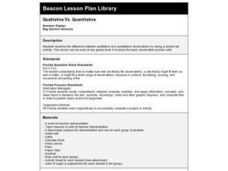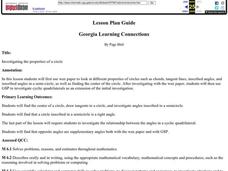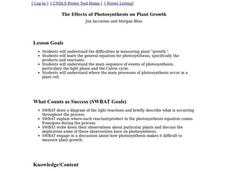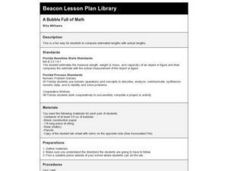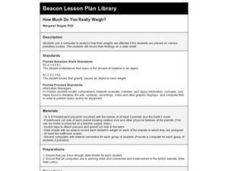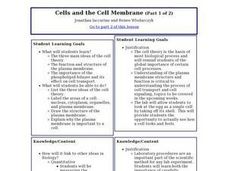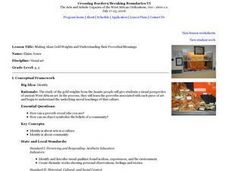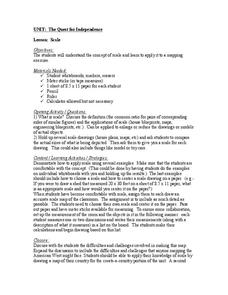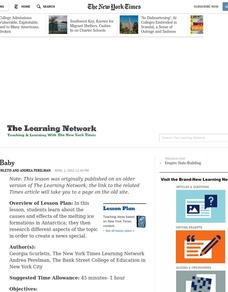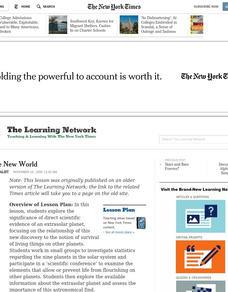Curated OER
Qualitative Vs. Quantitative
Fourth graders examine the difference between qualitative and quantitative observations by doing a simple lab activity. This instructional activity can be used at any grade level. It involves the basic observation process skill.
Curated OER
Star Power! Discovering the Power of Sunlight
Students estimate the energy output of the sun. They estimate how much power sunlight the sunlight provides to the earth. They build a simple device to measure the amount of solar radiation the earth receives from the sun.
Curated OER
How Much Water Does A Tree Transpire In A Day
Students engage in a lesson of investigating the amount of water that is transpired in a one day cycle. They conduct research to find the purpose of transpiration and find information to explain the value to a plant and explain how...
Curated OER
Investigating the properties of a circle
Students use wax paper to look at different properties of circles such as chords, tangent lines, inscribed angles, and inscribed angles in a semi-circle, as well as finding the center of the circle, and use GSP to investigate cyclic...
Curated OER
Faux Rice Paper Holiday Cards
Young scholars investigate the history of the uses of rice paper. They learn to use controlled brush pressure and work within a border that they create. Students use many materials to create a functional piece of artwork.
Curated OER
Build and Test
Learners display what they have learned about bridges as they construct their bridge. They present their projects to the rest of the class. They compare and contrast the construction of the bridges.
Curated OER
The Effects of Photosynthesis on Plant Growth
High schoolers are able to draw a diagram of the light reactions and briefly describe what is occurring throughout the process. They are able to explain where each reactant/product in the photosynthesis equation comes from/goes during...
Curated OER
Bacterial Transformation: Laboratory Experiment
Students participate in a group lab in which they complete the process of bacterial transformation. If lab procedures are followed correctly, Students see their results in a few days...bacteria glowing green.
Curated OER
Ice Cream: a Taste of Science!!
High schoolers define the term solution. They explain conservation of energy and energy transfer as it relate to how the milk solution became ice cream. Students are able to explain freezing point depression.
Curated OER
Let's Graph It!
Students graph the height of others in centimeters and inches, find the slope of line in order to calculate the conversion factor between centimeters and inches.
Curated OER
How Much Do You Really Weigh?
Sixth graders check to see how their weights differ if they weighed themselves on different planets. They record their findings on a data sheet.
Curated OER
How Much Gift Wrap Do I Need?
Students estimate the area of boxes using centimeter cubes. They find the actual area and compare it to the estimates.
Beacon Learning Center
Twix-n-Tween
Yummy! Use Twix candy bars to teach a instructional activity in comparing length! Learners will love this instructional activity and you will be addressing Common Core standards at the same time!
Curated OER
The Scientific Revolution
In this Scientific Revolution study guide worksheet, students read a brief overview pertaining to the topic and then respond to 6 reflection questions.
Curated OER
Cells and the Cell Membrane
Students investigate the properties of cell membranes by isolating the membrane surrounding chicken eggs. They set up an experiment by placing eggs in a vinegar solution for three days. A powerpoint lecture emphasizes the structure of...
Curated OER
Supernova Chemistry
Using spectroscopes, high school astronomy, physics, or chemistry learners observe emission spectra from several different sources. This stellar NASA-produced lesson plan provides terrific teacher's notes and a student handout. Make sure...
Curated OER
Making Akan Gold Weights and Understanding their Proverbial Meanings
Students examine a variety of gold weights used by the Asante in West Africa. In groups, they discuss the purpose of the gold weights and practice saying proverbs associated with different pieces of art. To end the lesson, they...
EngageNY
Describing Distributions Using the Mean and MAD
What city has the most consistent temperatures? Pupils use the mean and mean absolute deviation to describe various data sets including the average temperature in several cities. The 10th lesson in the 22-part series asks learners to...
Curated OER
Scale
Students apply concepts of scales to solve problems. In this geometry lesson, students solve real world problems using scales, proportions and ratios. They predict the actual size of a model given the scale drawings.
Curated OER
Ice, Ice, Baby
Students explore the causes and effects of the melting ice formations in Antarctica; they then research different aspects of the topic in order to create a news special.
Curated OER
Area
Young scholars solve problems involving area. In this geometry lesson plan, students calculate the area of an object and relate it to the area of the ocean. They define what exactly and area is and then solve problems relating to the...
Curated OER
A Whole New World
Students work in small groups to investigate statistics regarding the solar system and participate in a 'scientific conference'. They explore available information about the extrasolar planet and assess the importance of this...


